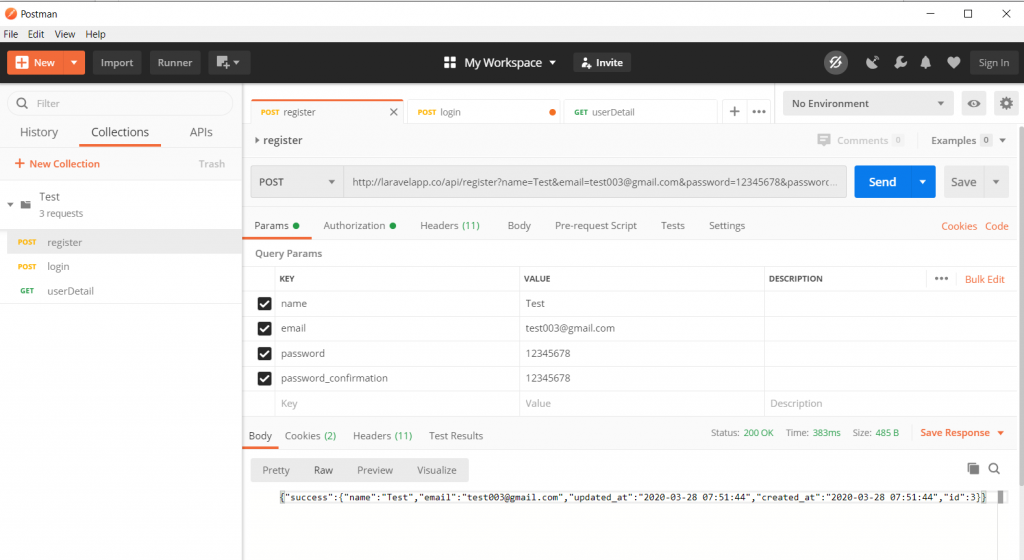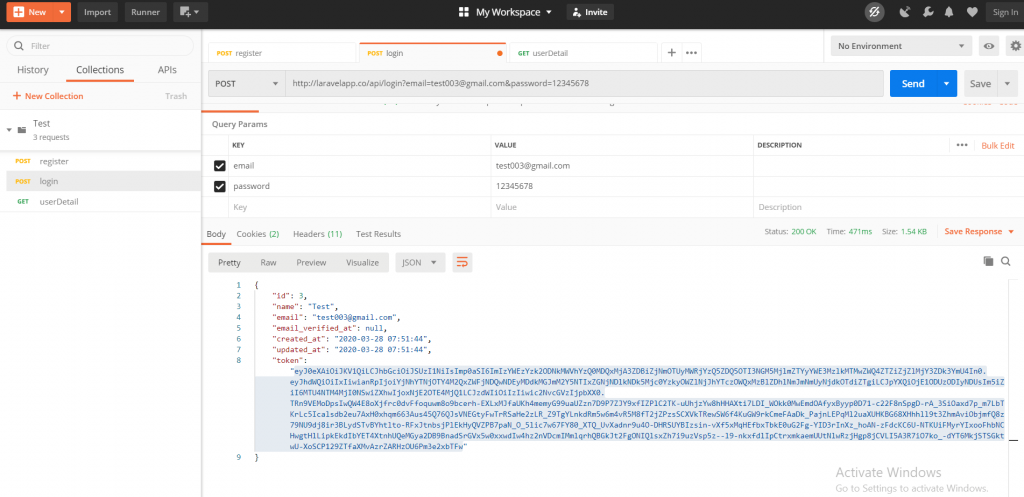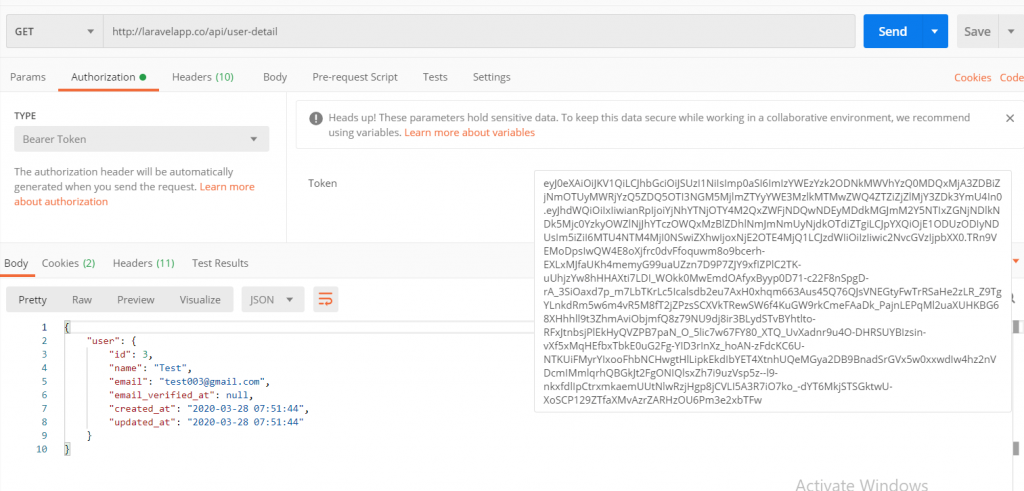Laravel Passport is a popular OAuth2 server package for Laravel that allows you to create secure APIs with token-based authentication. Here is a step-by-step guide on how to create a REST API using Laravel Passport User Authentication.

When a user login via API, a token is generated and sent to the user which is used for authentication purposes. Laravel provides Passport to work with API Authentication without any difficulties.
Download Laravel App
First of all, Open the terminal OR command prompt and run the following command to install laravel fresh app for laravel rest api user authentication:
composer create-project --prefer-dist laravel/laravel laravel-passportGo into the app:
cd laravel-passportSetup Database Credentials
Open the .env file and add your database credentials such as database name, username equally important password:
DB_CONNECTION=mysql
DB_HOST=localhost
DB_PORT=3306
DB_DATABASE=#db_name
DB_USERNAME=#db_username
DB_PASSWORD=#db_passwordInstall Passport Package
The second step leads us to install the passport package through the Composer package manager. Without further ado run the following command in your terminal.
composer require laravel/passportAfter successfully installing Laravel passport, register providers. Open config/app.php. and put the bellow code :
'providers' =>[
Laravel\Passport\PassportServiceProvider::class,
],Once the installation is complete, a new migration file containing the tables needed to store clients and access tokens will have been generated for your application. Run the following command to migrate your database:
php artisan migratePassport Configuration
Initialize Laravel Passport by running the passport:install command. This command will generate the encryption keys and create the necessary Passport clients and access tokens:
php artisan passport:installImmediately after the installation process from the preceding command is finished, add the Laravel\Passport\HasApiTokens trait to your App\Models\User model as shown here:
<?php
namespace App\Models;
use Illuminate\Contracts\Auth\MustVerifyEmail;
use Illuminate\Database\Eloquent\Factories\HasFactory;
use Illuminate\Foundation\Auth\User as Authenticatable;
use Illuminate\Notifications\Notifiable;
// use Laravel\Sanctum\HasApiTokens; // comment this
use Laravel\Passport\HasApiTokens; // include this
class User extends Authenticatable
{
use HasApiTokens, HasFactory, Notifiable;
/**
* The attributes that are mass assignable.
*
* @var array<int, string>
*/
protected $fillable = [
'name',
'email',
'password',
];
/**
* The attributes that should be hidden for serialization.
*
* @var array<int, string>
*/
protected $hidden = [
'password',
'remember_token',
];
/**
* The attributes that should be cast.
*
* @var array<string, string>
*/
protected $casts = [
'email_verified_at' => 'datetime',
];
}Next, open the app/Providers/AuthServiceProvider.php file and register the registerPolicies() method inside the boot() function, It will evoke the required routes.
<?php
namespace App\Providers;
use Illuminate\Support\Facades\Gate;
use Illuminate\Foundation\Support\Providers\AuthServiceProvider as ServiceProvider;
use Laravel\Passport\Passport;
class AuthServiceProvider extends ServiceProvider
{
/**
* The policy mappings for the application.
*
* @var array
*/
protected $policies = [
'App\Model' => 'App\Policies\ModelPolicy',
];
/**
* Register any authentication / authorization services.
*
* @return void
*/
public function boot()
{
$this->registerPolicies();
Passport::routes();
//
}
}After registering Passport::routes(), Laravel Passport is almost ready to handle all authentication and authorization processes within your application.
Finally, for your application to be ready to use Passport’s TokenGuard to authenticate any incoming API requests, open the config/auth configuration file and set the driver option of the api authentication guard to passport:
<?php
return [
/*
|--------------------------------------------------------------------------
| Authentication Defaults
|--------------------------------------------------------------------------
|
| This option controls the default authentication "guard" and password
| reset options for your application. You may change these defaults
| as required, but they're a perfect start for most applications.
|
*/
'defaults' => [
'guard' => 'web',
'passwords' => 'users',
],
/*
|--------------------------------------------------------------------------
| Authentication Guards
|--------------------------------------------------------------------------
|
| Next, you may define every authentication guard for your application.
| Of course, a great default configuration has been defined for you
| here which uses session storage and the Eloquent user provider.
|
| All authentication drivers have a user provider. This defines how the
| users are actually retrieved out of your database or other storage
| mechanisms used by this application to persist your user's data.
|
| Supported: "session"
|
*/
'guards' => [
'web' => [
'driver' => 'session',
'provider' => 'users',
],
'api' => [
'driver' => 'passport', // set this to passport
'provider' => 'users',
'hash' => false,
],
],
/*
|--------------------------------------------------------------------------
| User Providers
|--------------------------------------------------------------------------
|
| All authentication drivers have a user provider. This defines how the
| users are actually retrieved out of your database or other storage
| mechanisms used by this application to persist your user's data.
|
| If you have multiple user tables or models you may configure multiple
| sources which represent each model / table. These sources may then
| be assigned to any extra authentication guards you have defined.
|
| Supported: "database", "eloquent"
|
*/
'providers' => [
'users' => [
'driver' => 'eloquent',
'model' => App\Models\User::class,
],
// 'users' => [
// 'driver' => 'database',
// 'table' => 'users',
// ],
],
/*
|--------------------------------------------------------------------------
| Resetting Passwords
|--------------------------------------------------------------------------
|
| You may specify multiple password reset configurations if you have more
| than one user table or model in the application and you want to have
| separate password reset settings based on the specific user types.
|
| The expire time is the number of minutes that each reset token will be
| considered valid. This security feature keeps tokens short-lived so
| they have less time to be guessed. You may change this as needed.
|
*/
'passwords' => [
'users' => [
'provider' => 'users',
'table' => 'password_resets',
'expire' => 60,
'throttle' => 60,
],
],
/*
|--------------------------------------------------------------------------
| Password Confirmation Timeout
|--------------------------------------------------------------------------
|
| Here you may define the amount of seconds before a password confirmation
| times out and the user is prompted to re-enter their password via the
| confirmation screen. By default, the timeout lasts for three hours.
|
*/
'password_timeout' => 10800,
];Create API Route for Passport
Now, we will define API routes. Go to the routes/api.php file and declare the foundational code.
<?php
use Illuminate\Http\Request;
use Illuminate\Support\Facades\Route;
use App\Http\Controllers\Api\AuthController;
/*
|--------------------------------------------------------------------------
| API Routes
|--------------------------------------------------------------------------
|
| Here is where you can register API routes for your application. These
| routes are loaded by the RouteServiceProvider within a group which
| is assigned the "api" middleware group. Enjoy building your API!
|
*/
Route::post('register', [AuthController::class, 'register']);
Route::post('login', [AuthController::class, 'login']);
Route::middleware('auth:api')->group(function () {
Route::post('/logout', [AuthController::class, 'logout']);
Route::get('get-user', [AuthController::class, 'userDetail']);
});Create Controller
Next, you need to create a new controller create to implement laravel passport authentication.
php artisan make:controller Api/AuthControllerNow, open the app\Http\Controllers\Api\AuthController.php file and update the following code on it.
<?php
namespace App\Http\Controllers\Api;
use App\Http\Controllers\Controller;
use Illuminate\Http\Request;
use Illuminate\Support\Facades\Validator;
use Illuminate\Support\Facades\Hash;
use Illuminate\Support\Facades\Auth;
use App\Models\User;
class AuthController extends Controller
{
public function register(Request $request)
{
$requestData = $request->all();
$validator = Validator::make($requestData,[
'name' => 'required|max:55',
'email' => 'email|required|unique:users',
'password' => 'required|confirmed'
]);
if ($validator->fails()) {
return response()->json([
'errors' => $validator->errors()
], 422);
}
$requestData['password'] = Hash::make($requestData['password']);
$user = User::create($requestData);
return response([ 'status' => true, 'message' => 'User successfully register.' ], 200);
}
public function login(Request $request)
{
$requestData = $request->all();
$validator = Validator::make($requestData,[
'email' => 'email|required',
'password' => 'required'
]);
if ($validator->fails()) {
return response()->json([
'errors' => $validator->errors()
], 422);
}
if(! auth()->attempt($requestData)){
return response()->json(['error' => 'UnAuthorised Access'], 401);
}
$accessToken = auth()->user()->createToken('authToken')->accessToken;
return response(['user' => auth()->user(), 'access_token' => $accessToken], 200);
}
public function userDetail(Request $request)
{
$user = $request->user();
return response()->json(['user' => $user], 200);
}
public function logout (Request $request)
{
$token = $request->user()->token();
$token->revoke();
$response = ['message' => 'You have been successfully logged out!'];
return response($response, 200);
}
}Now you can check the Laravel passport to rest api example just running the artisan serve command if you did’t use the virtual host in your app.
php artisan serveNow check your api requests we have added images to sending the requests.
Test API Requests
You can test this api request using Postman.
Register Api In Postman

Laravel Register api request
Login Api In Postman

Laravel Login Api request
userDetail APi in Postman
To getting the user details we need to add accept and authorization in header section on postman.
‘headers’ => [
‘Accept’ => ‘application/json’,
‘Authorization’ => ‘Bearer ‘.$accessToken,
]Getting details Api In Postman

That’s it! You have successfully created a REST API using Laravel Passport. You can extend the API by adding more routes, controllers, and logic as per your project requirements.
Hello, i’m thankful for this tutorial you provided, you just forgot to mention where the token will be generated,
i guess it should be in the registration method
……………
$user = User::create($user);
$accessToken = $user->createToken(‘authToken’)->accessToken;
and we just pass it to the json response:
return response()->json([‘success’=>$user,’access_token’ => $accessToken]);
can u please add laravel 7 + mongodb +passport api
thank you very much!